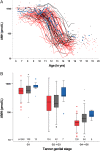The AMH genotype (rs10407022 T>G) is associated with circulating AMH levels in boys, but not in girls
- PMID: 29358304
- PMCID: PMC5825925
- DOI: 10.1530/EC-17-0299
The AMH genotype (rs10407022 T>G) is associated with circulating AMH levels in boys, but not in girls
Abstract
Objective: Fetal anti-Müllerian hormone (AMH) is responsible for normal male sexual differentiation, and circulating AMH is used as a marker of testicular tissue in newborns with disorders of sex development. Little is known about the mechanism of action in postnatal life. A recent genome wide association study (GWAS) reported genetic variation of AMH affecting AMH levels in young men. This study investigated the effect of genetic variation of AMH and AMH type II receptor (AMHR2) (AMHrs10407022 T>G and AMHR2rs11170547 C>T) on circulating reproductive hormone levels and pubertal onset in boys and girls.
Design and methods: This study is a combined longitudinal and cross-sectional study in healthy Danish boys and girls from the general population. We included 658 boys aged 5.8-19.8 years and 320 girls aged 5.6-16.5 years. The main outcome measures were genotyping of AMH and AMHR2, pubertal staging and serum levels of reproductive hormones.
Results: AMHrs10407022T>G was associated with higher serum levels of AMH in prepubertal boys (TT: 575 pmol/L vs TG: 633 pmol/L vs GG: 837 pmol/L, P = 0.002) and adolescents (TT: 44 pmol/L vs TG: 58 pmol/L vs GG: 79 pmol/L, P < 0.001). Adolescent boys carrying the genetic variation also had lower levels of LH (TT: 3.0 IU/L vs TG: 2.8 IU/L vs GG: 1.8 IU/L, P = 0.012). Hormone levels in girls and pubertal onset in either sex did not seem to be profoundly affected by the genotypes.
Conclusion: Our findings support recent GWAS results in young adults and expand our understanding of genetic variation affecting AMH levels even in boys prior to the pubertal decline of circulating AMH.
Keywords: anti-Mullerian hormone; anti-Mullerian hormone receptor; puberty; single-nucleotide polymorphism.
© 2018 The authors.
Figures

Similar articles
-
FSHB -211 G>T is a major genetic modulator of reproductive physiology and health in childbearing age women.Hum Reprod. 2018 May 1;33(5):954-966. doi: 10.1093/humrep/dey057. Hum Reprod. 2018. PMID: 29617818
-
Genetic variations altering FSH action affect circulating hormone levels as well as follicle growth in healthy peripubertal girls.Hum Reprod. 2016 Apr;31(4):897-904. doi: 10.1093/humrep/dew022. Epub 2016 Feb 23. Hum Reprod. 2016. PMID: 26905078
-
[Anti-Müllerian hormone (AMH) measurements in the assessment of testicular function in prepubertal boys and in sexual differentiation disorders].Endokrynol Diabetol Chor Przemiany Materii Wieku Rozw. 2006;12(3):195-9. Endokrynol Diabetol Chor Przemiany Materii Wieku Rozw. 2006. PMID: 17020655 Polish.
-
Anti-Müllerian hormone as a marker of steroid and gonadotropin action in the testis of children and adolescents with disorders of the gonadal axis.Int J Pediatr Endocrinol. 2016;2016:20. doi: 10.1186/s13633-016-0038-2. Epub 2016 Oct 28. Int J Pediatr Endocrinol. 2016. PMID: 27799946 Free PMC article. Review.
-
Anti-müllerian hormone and sertoli cell function in paediatric male hypogonadism.Horm Res Paediatr. 2010;73(2):81-92. doi: 10.1159/000277140. Epub 2010 Feb 9. Horm Res Paediatr. 2010. PMID: 20190544 Review.
Cited by
-
Delaying testicular sperm extraction in 47,XXY Klinefelter patients does not impair the sperm retrieval rate, and AMH levels are higher when TESE is positive.Hum Reprod. 2022 Oct 31;37(11):2518-2531. doi: 10.1093/humrep/deac203. Hum Reprod. 2022. PMID: 36112034 Free PMC article. Clinical Trial.
-
Genetic and histopathological analysis of transverse testicular ectopia without persistent Müllerian duct syndrome: two case reports.J Med Case Rep. 2020 Dec 1;14(1):233. doi: 10.1186/s13256-020-02559-7. J Med Case Rep. 2020. PMID: 33256838 Free PMC article.
-
Association of two single nucleotide polymorphisms rs10407022 and rs3741664 with the risk of primary ovarian insufficiency in a sample of Iraqi women.Mol Biol Res Commun. 2020 Dec;9(4):141-144. doi: 10.22099/mbrc.2020.36371.1477. Mol Biol Res Commun. 2020. PMID: 33344660 Free PMC article.
References
LinkOut - more resources
Full Text Sources
Other Literature Sources
Miscellaneous

